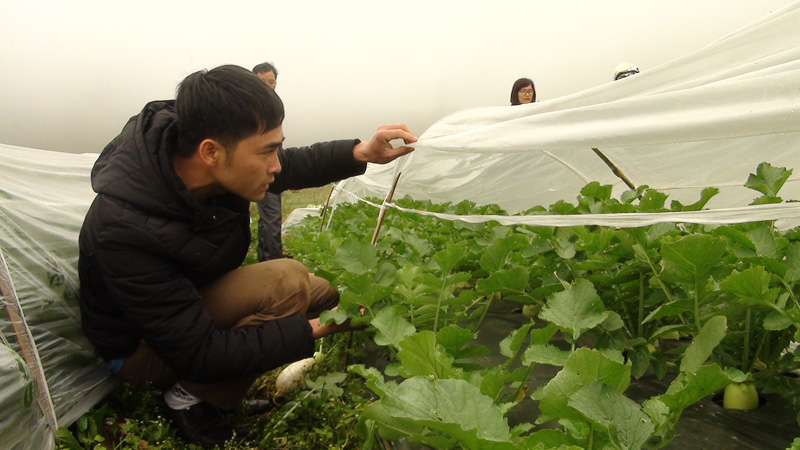
(HBO) - Taking advantage of the cool weather conditions of Quyen Chien Highland Commune, Mr. Bui Van Tan, Doi Village, Tuan Lo Commune, Tan Lac District has bravely leased land to invest in growing "imported” vegetables, which are originated from Korea with varieties such as radish, green onion, cabbage and cauliflower ... with initial effectiveness.

Mr. Bui Van Tan, Doi Village, Tuan Lo Commune
(Tan Lac) checked the Korean radish seedlings.
In May of 2017, Tan decided to go to Quyet
Chien and survey the soil in Bieng village and found that it was suitable for
growing varieties of vegetables. He negotiated with his family to rent the land
areas of 8 households with an area of nearly 1.5 hectares in 5 years with the
rent of 23 million VND / ha. During the implementation, he was assisted by GNI
Project (Good Neighbors International), a Korean non-governmental organization
that supports the growers who plant vegetables originated from South Korea. The
project has supported his family in terms of technology. At the same time, the
GNI Project acts as an intermediary to connect enterprises in product
consumption. So, he was more confident when implementing the model.
With the Korean radish variety, Tan has
planted 5,000 m2 and 1,200 m2 of green onion. It depends on the different
seasons and planting time, for example, the summer crop of radish will take
about 55 - 65 days, the winter crop takes about 65-75 days to harvest, the weight is also different. At this time, the
weather is still cold, the radish grows well so the weight reaches at 2.4 kg /
the biggest bulb, the average is 1.2 kg / bulb. They are selling at the price
of 12,000 VND / kg (if being planted in the summer, the sale price is up to
18,000 - 20,000 VND / kg). With green onions, he can harvest only after 4
months. The average weight of 3 gr / one green onion and it is selling at the
price of 20,000 VND / kg.
Mr. Bui Van Tan shared: Growing Korean
vegetables and roots gives very high productivity. By the end of 2017, my
family earned 15 tons of radishes, 2 tons of green onions, collected more than
100 million VND after deducting all the expenses. By the beginning of 2018,
turnips and green onion products will be harvested; the yield is expected to be
higher than in the previous year. Apart from productivity and output, factors
of design and product quality must be taken into consideration. To satisfy the
customers’ expectation, the products must be beautiful in design but absolute
safe in quality for consumers, so the products can be sustainable. Therefore,
my radish and green onion products do not meet the demand.
It can be said that the model of planting
"imported" vegetables of Mr. Bui Van Tan has many prospects, bringing
many clean and new products of upland communes to the market. In the upcoming time,
he plans to grow in all the land which he has rented and created jobs for local
households at the same time.
According to data from the Hoa Binh Provincial Party Committee, the industrial production index for the first six months of 2025 is estimated to have increased by 20% compared to the same period last year. This marks the highest year-on-year growth rate for this period since 2020.
In the first six months of 2025, Hoa Binh province’s export turnover was estimated at 1.145 billion USD, marking an 18.11% increase compared to the same period in 2024. Import turnover was estimated at $ 804 million, a 17.15% increase, which helped the province maintain a positive trade balance.
The lives of the ethnic minority farmers in Tan Lac district have gradually improved thanks to the new directions in agricultural production. This is a testament to the collective strength fostered through the professional associations and groups implemented by various levels of the district’s Farmers’ Union.
With the motto the "product quality comes first,” after nearly one year of establishment and operation, Muong village’s Clean Food Agricultural and Commercial Cooperative, located in Cau Hamlet, Hung Son Commune (Kim Boi district), has launched reputable, high-quality agricultural products to the market that are well-received by consumers. The products such as Muong village’s pork sausage, salt-cured chicken, and salt-cured pork hocks have gradually carved out a place in the market and they are on the path to obtaining the OCOP certification.
In the past, the phrase "bumper harvest, rock-bottom prices" was a familiar refrain for Vietnamese farmers engaged in fragmented, small-scale agriculture. But today, a new spirit is emerging across rural areas of Hoa Binh province - one of collaboration, organisation, and collective economic models that provide a stable foundation for production.
Maintaining growing area codes and packing facility codes in accordance with regulations is a mandatory requirement for agricultural products to be eligible for export. Recently, the Department of Agriculture and Environment of Hoa Binh province has intensified technical supervision of designated farming areas and packing facilities to safeguard the "green passport" that enables its products to access international markets.



